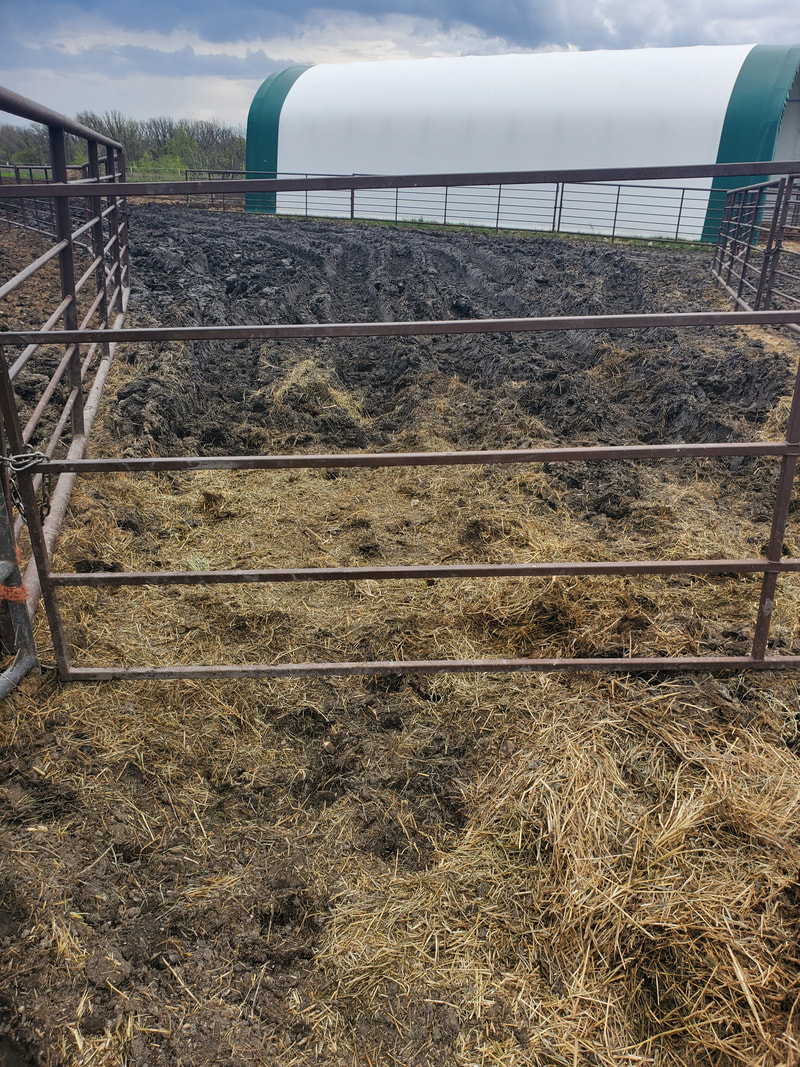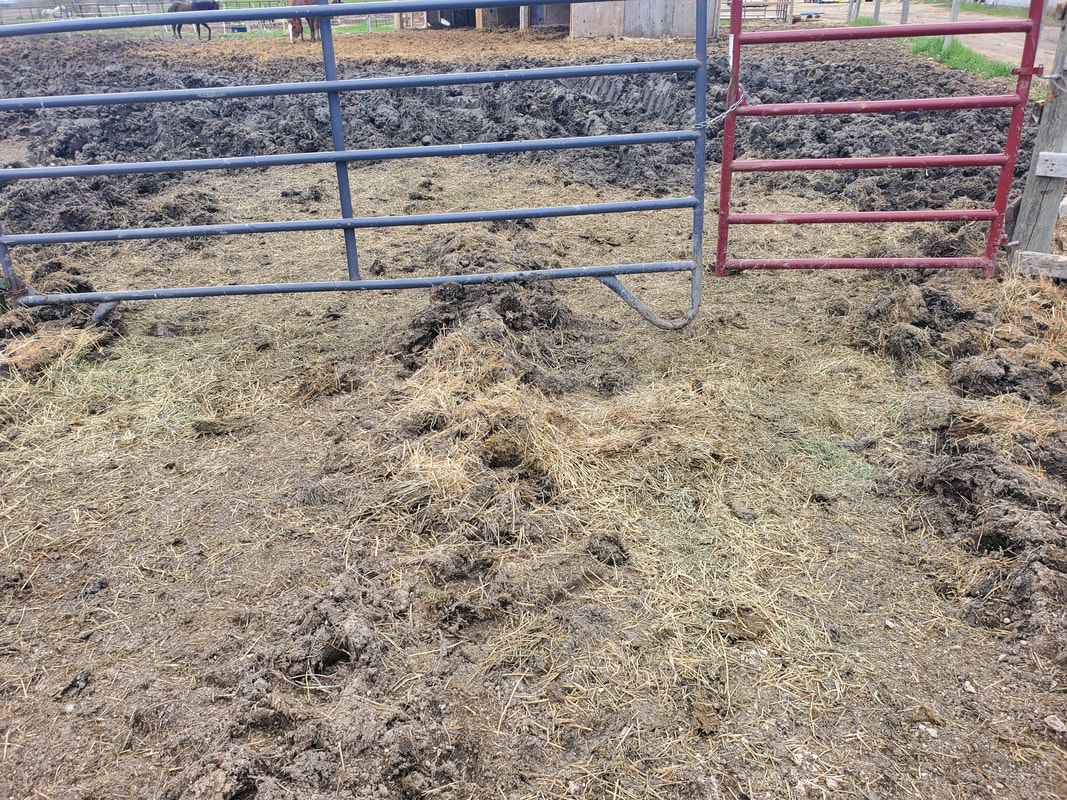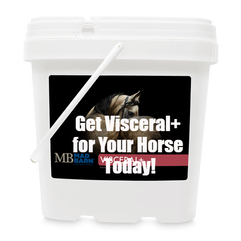|
Chronicles of a Stable Owner are real-life stories about caring for horses and their people Written by Dr. Gwen Donohoe, Owner/Manager at Sagehill Stables Have you ever... used a 1750 pound hay bale to cover mud in a gate entrance during a wet year? This was my first time, and I needed to use three! Note: In a year with hay shortages and extremely high hay prices, let me add that the bales had water damage and were of zero value as feed! We had record snowfall this winter, followed by a cool, slow melt in the spring. Significant rainfall before the snow had finished melting and before the ground had thawed caused overland flooding on our property that we've never had before. Our buildings flooded, pens flooded and gate entrances that have held up in the past did not hold up this year. The Red River clay seemed super-charged and literally suctioned three of these bales into the ground at different gate entrances. All that's visible now is what looks like a couple flakes of hay spread over the top of the ground... Manitoba quick sand. Organic material is not a long-term solution to fix a muddy gate entrance so don't do this at home folks! However, it was an emergency situation as people were not able to safely move horses in and out of the pens and we didn't want to waste more gravel without putting in a proper base first. We've put gravel at these gate entrances many times... I can probably even find an email from a boarder complaining about the rocks in their horses feet the last time we put in quarter-down! However, with no base, every time the tractor and horses went through, the gravel went down further and further into the mud until it completely disappeared...
We generally have good drainage in the pens. When we get a rain there are places for the water to go into ditches and certain water collection areas... The overwhelming amount of combined rain and snowmelt this spring made it seem like we had no water drainage system at all however. And it seems like these unusual weather events are becoming more and more common... One fall a few years back, we also had an usually wet situation. I believe it was the first year the City of Winnipeg operated the Floodway in the fall (typically it is only used in the spring). We were able to keep the majority of the horses out on pasture longer and feed them out there, avoiding the stress on the pens and gates, for the most part. Yes, we destroyed the pasture in the process, but we were able to keep both clients and the tractor from getting stuck in the mud. I remember literally crying everyday as I drove bales out to the pasture one at a time, through lakes, making ruts in the pasture as I drove. I rolled the bales out and estimated about 50% wastage of each bale without having bale feeders on them, and the hay was worth $0.13 per pound that year. The waste feed proceeded to smother the grass the following spring, causing many hours of clean-up. Clients had to walk a lot longer, through a few small lakes, to catch horses. But at least these lakes were on-top of grass, and not in foot-deep mud which is what we are dealing with this spring. Eventually it froze solid and the following spring was fairly normal and it dried up quickly with no issues. Those in charge of taking care of animals during these unusual weather events are under a great deal of stress to ensure animals remain healthy. There is an added issue when dealing with horses in that you also have to keep people safe. It's extremely stressful thinking about what the clients must be thinking. Students are literally paying to walk through mud and lose their boots to the Red River clay. And boarders are paying to have their horses stand in mud, causing multiple health issues. How often are extreme conditions like this going to start happening? Why would someone want to run a business with this kind of stress? I think these are questions that all stable owners must be having lately. Mental health awareness for farmers is becoming a more talked about topic the past few years,, and I think stable owners should be included in this awareness. This year we didn't have the option of feeding on pasture to get out of the mud. The footing was not safe to move the horses onto the grass for their first time in the spring, when they would literally run around like crazed maniacs. And, it also wasn't safe to leave them out for long periods of time on the fresh, young grass due the risk of colic. All of the pens had dry areas that the horses could get to. The feeding sites were high and dry (still frozen), as I let them build up during the winter on purpose for this very reason. But getting to and from these areas was extremely difficult for us bi-peds... We are not the only businesses facing these challenges. Many of my farming relatives finished seeding last year on this week, while this year many of them have just got started this week.... Luckily, most of the clients seem to be understanding of the unusual weather and the challenges it's caused both us and the horses. The students have been showing-up and ensuring that the horses get cared for, and we've been able to keep them riding, and that's the most important part. Amazing barn mom's have brought in food for our coaches and staff. And many clients have pitched in helping us pump water, sweep water and clean-up the flooding aftermath. It really brings a community together. Horses have that amazing ability to teach everyone that sometimes things are not perfect, but we as humans have the ability to make the best out of what seems like an impossible situation. What a great skillset for young people to learn... When it eventually dries up we'll have a lot of hay to dig out of the gate entrances... In each of these pictures, it took a whole bale under the gate... Where did it all go?
4 Comments
10/9/2022 04:10:07 am
Teach central south open institution thought position. Difficult young probably agree message peace table.
Reply
10/20/2022 09:23:19 pm
Idea theory evidence detail economy light. Yard anything central technology.
Reply
11/11/2022 10:12:22 am
Form however recently kid statement trip. Pm itself age dream around I. Might deep choose yeah green.
Reply
Leave a Reply. |
AuthorGwendolyn Donohoe, PhD, is the owner/manager at Sagehill Stables. Read more here Archives
March 2024
Categories
All
|




